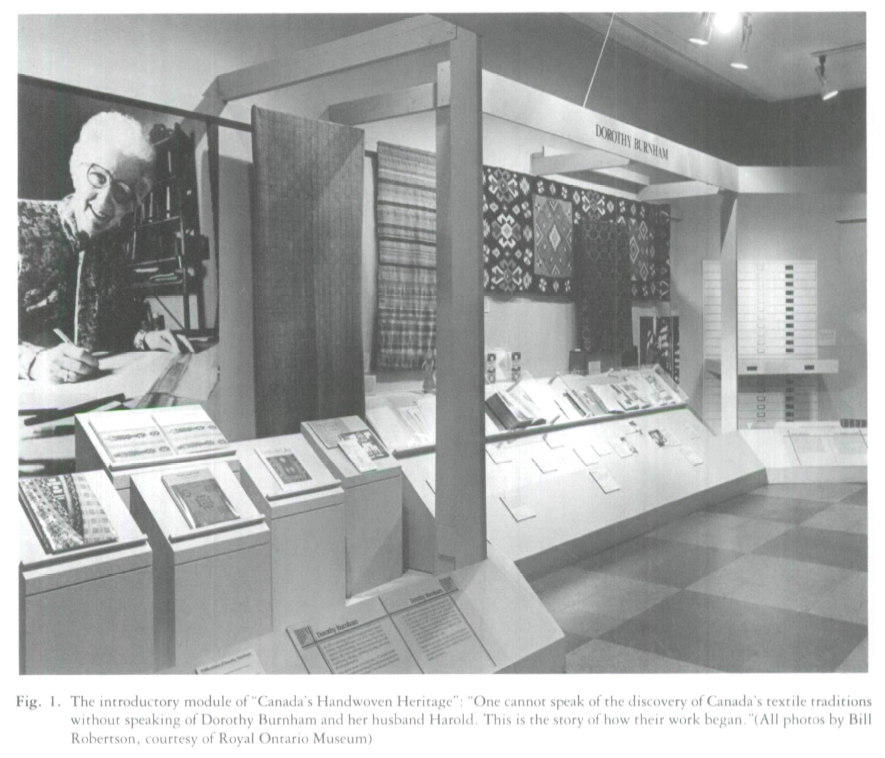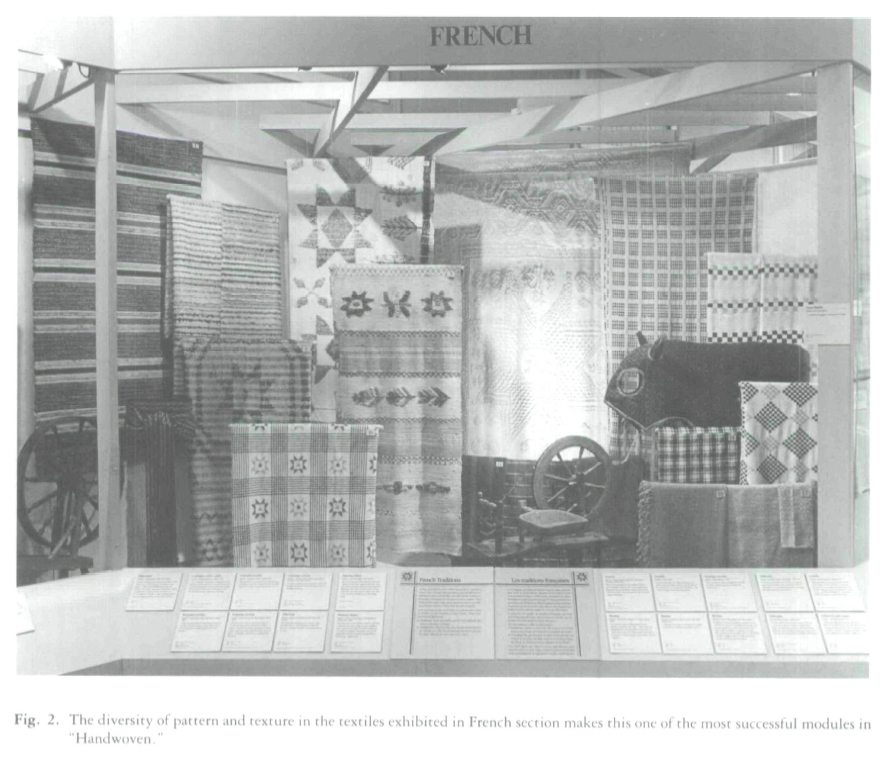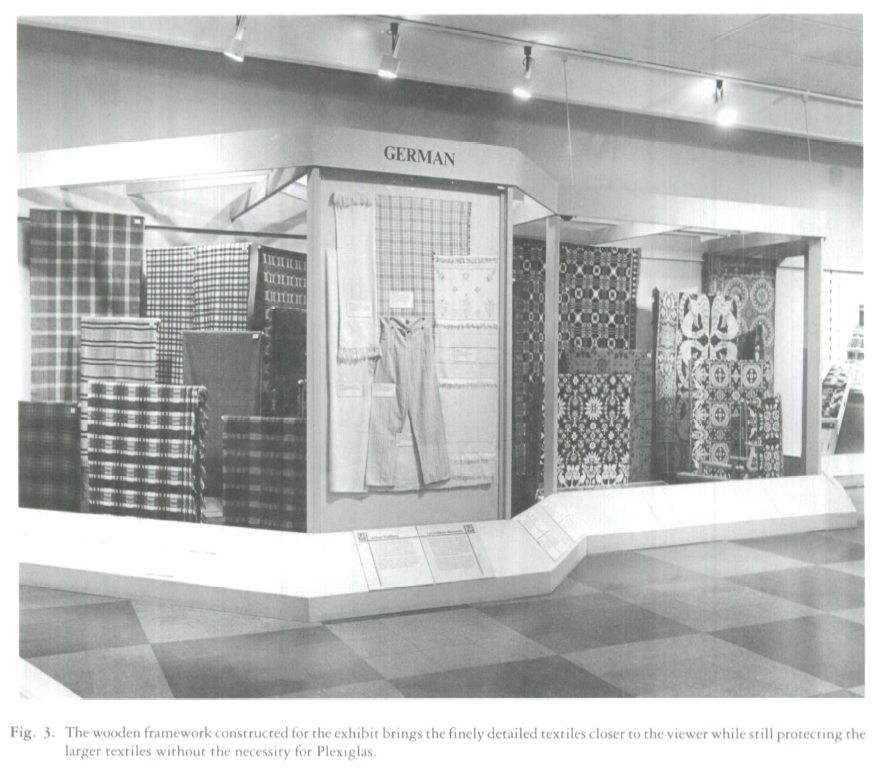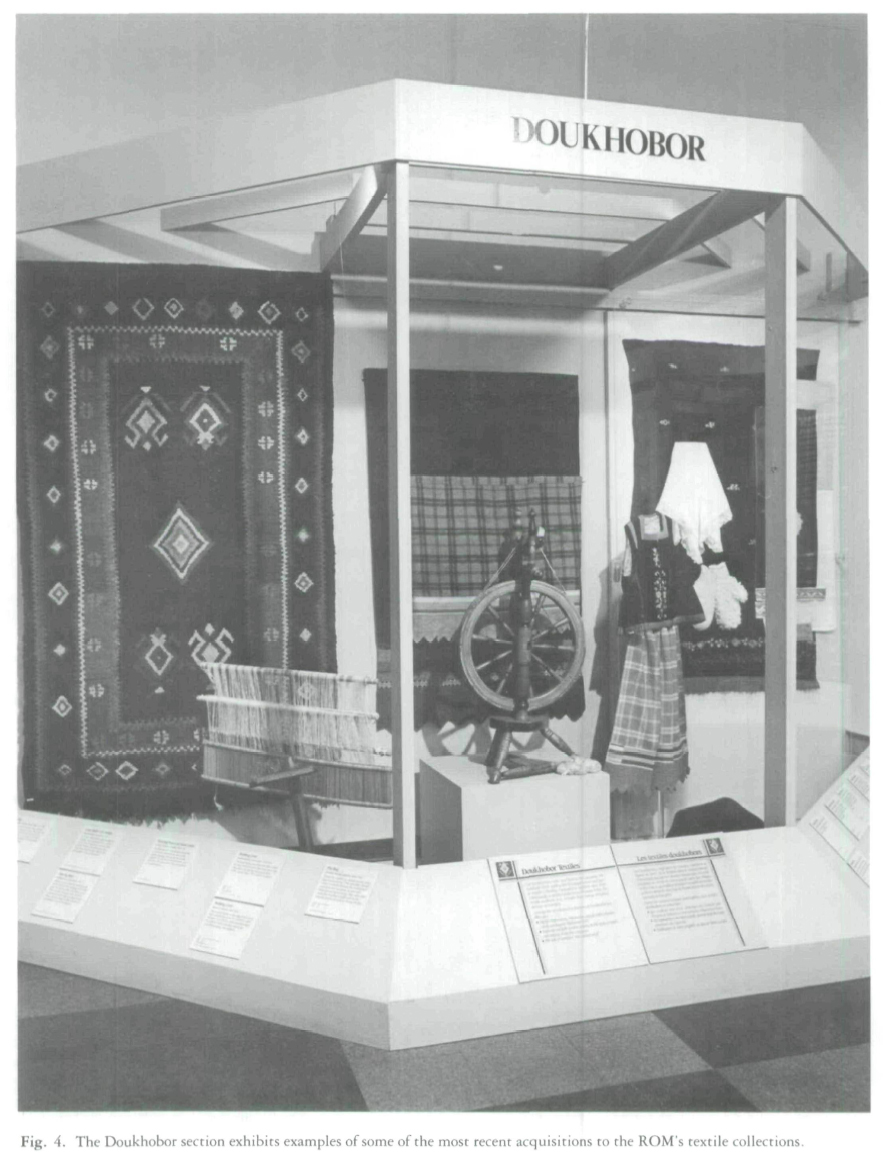Reviews / Comptes rendus
Royal Ontario Museum, "Canada's Handwoven Heritage"
1 "Canada's Handwoven Heritage" was developed in response to a request from the organizers of Convergence '86, the biennial meeting of the Handweavers' Guild of America, which was to take place outside of the United States for the first time. The handweaving enthusiasts "converging" on Toronto for that two-week period in July were the exhibit's prime target audience and it was perceived that their main interest would be in viewing as many examples from the Royal Ontario Museum's extensive Canadian textile collection as was possible in a temporary exhibit. In addition, handweavers on both sides of the border had long been familiar with the prodigious work of Dorothy Burnham, the main moving lone behind the ROM's collection, and the exhibit seemed like an appropriate way to pay tribute to her remarkable work. By documenting her contribution to the history of Canada's handweaving heritage over the past 45 years, a more personal dimension could be added to the remarks she would make as keynote speaker at the conference.
2 From this perspective, there is little doubt that the guild members got what they came for. The ROM's collection contains some of the best extant examples of Canadian handweaving, and the artifacts chosen for the exhibit from the more than 2,000 pieces in the collection illustrated well the collection's strengths — its diversity and its ethnicity. The storyline, too, was developed in a manner that highlighted the distinct handweaving traditions of Canada's main cultural groups and explained the distinctions in easily comprehended terms.
3 The artifacts were grouped in a number of modules representing Acadian, French, British, Doukhobor and German handweaving forms, and each was examined according to pattern motifs, weave structures, and equipment used. As the exhibit's introductory panel outlined, the intended focus was more historical than technical, although sufficient explanation of the different weaving techniques was included to assist the neophyte in identifying variations. For those desiring a more detailed explanation of weaving terms and structures, copies of Burnham's Warp and Weft: A Textile Terminology were available in the exhibit area.
4 It is unfortunate, however, that more historical/geographical information was not included, particularly for the visitor from out-of-country who might not be familiar either with settlement patterns or with regional aberrations in the handweaving of the cultural groups represented. For instance, the lead label for the Acadian section explained that the Acadians were farmers who settled near the Bay of Fundy, although most of the examples exhibited originated in Cape Breton. In the French section a large proportion of the artifacts dated from the late nineteenth and early twentieth centuries, yet there was no explanation for the relatively late continuation of handweaving by these peoples long after industrialization had had a major impact on textile production in other areas. An explanatory note on the numerous examples of Samuel Fry's work, representing Canada's Germanic weavers, would also have been helpful. As one of the few Pennsylvania-German Mennonite weavers documented to date, he may well be atypical. By far the largest proportion of Germanic weavers practising their trade in Canada in the nineteenth century received their training in Germany.
5 Other tantalizing details also begged more historical framework. Does a cultural tradition exist that explains the weaving of elaborate tablecloths in Quebec? Several unusual examples were exhibited, including one outstanding one from the late nineteenth century featuring embroidered eight-point stars on a linen-and-wool woven ground. What accounts for the frequent production of the elaborately woven multiple-shaft horse blankets in areas of Ontario settled by Germans? And why does the small extra button on the Doukhobor vest indicate that the weaver was a vegetarian?
6 These minor deficiencies were more than compensated for, however, by the visual least the exhibit provided. The delightful interplay of colour and texture in handwoven textiles, coupled with the subtle gradations of colour achieved by natural dyes, made these textiles wonderful subjects for display. Of particular note in this regard in "Handwoven" was the outstanding assemblage of carpet fragments in the British section that so strikingly illustrated the richness of colour and design that unsophisticated craftsmen working with unsophisticated tools were able to produce. Though most of the textile examples were unavoidably two dimensional, with bedding and household linens predominating, the inclusion of handwoven clothing and of an array of different textile production tools added variety and interest and provided further points of comparison between the various ethnic groups.
 Display large image of Figure 1
Display large image of Figure 17 The approach taken by the design team succeeded in overcoming limitations imposed by time, resources, space, and inappropriate equipment. Curators of small museum operations should take heart in the knowledge that "Canada's Handwoven Heritage" was conceptualized, designed, and installed in just under tour months and on a modest budget, certainly by ROM's standards. The mounting techniques were simple yet effective. Textiles were hung over padded dowels suspended by fish line from a wooden framework. In this way the artifacts could be layered and a number of good examples displayed within a limited space. This also allowed more of the textiles to be exposed so that the viewer, especially the Convergence '86 weavers, could more fully appreciate the impact of the design and pick up pattern repeats and other design and construction details. Appreciated too, was the unimpeded view of the textiles; Plexiglas was used for protection only where artifacts with subtle design details, such as the patterned linens, were brought closer to the viewer. From a conservation viewpoint, however, it is to be hoped that dust levels were well controlled in the gallery, minimizing damage to the textiles over the eight months they were on exhibit.
 Display large image of Figure 2
Display large image of Figure 2 Display large image of Figure 3
Display large image of Figure 38 Installed in the print gallery of the Canadiana building, the exhibit also suffered somewhat from the inflexibility of the lighting system. However, light levels were appropriately low and in one instance a dramatic touch was added with the use of a raking light from below that highlighted the striking texture of a French boutonné coverlet.
9 One less positive feature of the design was the location of the labels. Placed on a sloping surface, in most cases less than 61 cm (2 ft.) from the floor, they certainly did not detract from the beauty of the textiles. On the other hand, much of the print was too small to be comfortably read from that distance by the youthful eye, let alone the aged one, and it was disconcerting to proceed through the exhibit with the eye directed down rather than at the artifacts themselves.
10 The working title for this exhibit was "Discovering Canada's Handwoven Heritage." In a very informative article of the same name written for the summer issue of Rotunda, curator Adrienne Hood chronicled the work of Dorothy Burnham over the past 45 years and whetted the appetite for an exhibit that would be a true retrospective of her remarkable career. As the exhibit evolved, however, the word discovering was dropped from the title, and the discovery component of the original concept was reduced, surviving only in the two modules that bracketed the main body of the exhibit. The first detailed how Dorothy and husband Harold got their start and was accompanied by the artifact that initially piqued their curiosity in 1941, a blue-and-white overshot coverlet. The last module of the exhibit, entitled "Research," indicated how the textile collections had been used in advancing knowledge about the material culture of Canada and mentioned recent research projects that are continuing the work begun by the Burnhams.
 Display large image of Figure 4
Display large image of Figure 411 A good deal of material had already been published on the ROM's Canadian textile collection. Opportunities had also been provided for the artifacts to be viewed; in addition to this current exhibit, the National Gallery of Canada's travelling exhibition of 1981, "The Comfortable Arts," included numerous examples from the ROM collections. It can be said that Canadian handweaving has finally come to its own. Perhaps the time was right for an exhibit that truly dealt with the discovery process, one that revealed the research and collecting techniques, the inspirations, the triumphs, the disappointments, the personal details of the Burnhams' quest. At a time when many museum curators find fewer and fewer hours to actively build collections or adequately research them, the inspiring personal example of the Burnhams could provide a much-needed impetus.
Curatorial Statement
12 In July, 1986, the Handweavers' Guild of America held their biennial meeting, Convergence '86, in Toronto. The group, which had never met outside the United States, chose Toronto in part because of the Canadian handweaving collection at the Royal Ontario Museum, made famous by Dorothy Burnham and Harold Burnham through their book Keep Me Warm One Night, Early Handweaving in Eastern Canada (Toronto: University of Toronto Press, 1972). In fact, Dorothy Burnham gave the conference's keynote address to some 3,000 weavers attending from all over the world.
13 In conjunction with this event, the organizers asked the ROM to mount an exhibit of Canadian handweaving. The permanent textile galleries at the ROM have not yet opened, but the members of the Textile Department felt it was important to respond to this public request. We therefore obtained the use of a gallery at the Sigmund Samuel Canadiana Building. Although this space was not designed for displaying textiles, we felt we could resolve any problems in order to make the collection accessible during this important international meeting.
14 Because the task of completing permanent galleries commands high priority at the ROM, the mounting of small, temporary exhibits must be done using minimal money, time and labour. With a budget of about $6000 and a time frame of four months from the initial meetings of the design team in late January until opening day in late May, we had to design, select artifacts for, and install the exhibit with maximum efficiency and creativity. We extended our budget by using as much recycled material as possible, but the lack of time posed more problems. For example, we were hard pressed to arrange publicity and programming to enhance the exhibit. Although we met the opening deadline, we all worked a great deal of over-time to do so. Unquestionably, even small shows need a sufficient amount of time to meet all contingencies.
15 The ROM advocates a team approach to exhibition design which, with the right combinations of personalities and experience, I strongly support. In the case of "Canada's Handwoven Heritage" the clearly defined territories of the curator, designer and programmer dissolved. However, as the curator I had some ideas for the exhibit based on my knowledge of the collection and on a familiarity with the weaving community. Both the designer, Henry Sears, and the programmer, Rita Johnson, helped me to focus my ideas into a realizable form. The team's fresh outlook highlighted interesting facts that I had lost sight of as my research became more specialized. With the help of assistant designer, Lynne Appleby, Henry Sears very early provided a structure for our ideas in the form of a floor plan, followed quickly by a scale model. I selected the artifacts and wrote the 200 labels for these, while Rita Johnson was instrumental in maintaining a clear concept, writing and editing the voluminous label copy, and coordinating all the departments involved in constructing and installing the exhibit.
16 At our first meeting we decided that the exhibit should focus on the lifetime involvement of Dorothy Burnham with Canadian textiles, as well as the extensive ROM collection (more than 2,000 Canadian pieces). Also, knowing that the weavers in the audience would want to see as much as possible, we realized the exhibit would have to be artifact-rich.
17 Because the Burnhams had analyzed textile structures in their publications, we felt we could move beyond this approach. Moreover, requests I had received since taking over the Canadian collection indicated that the public was increasingly interested in its evolution and the methods used to research it.
18 We decided to show how the first piece of Canadian handweaving offered to the museum in 1941 piqued the curiosity of a young Dorothy Burnham. In the following section we traced the evolution of the Canadian Textile Project and Dorothy's involvement from its start, with a questionnaire at the Canadian National Exhibition in 1947, through the 1960s, when it expanded to include all of Eastern Canada, up until the present with Dorothy's latest work on Doukhobor textiles in the West. This story was illustrated with material culled from the Textile Department archives, including original questionnaires, letters written in response to these, research reports, and early publications, and was further supplemented with diaries and photographs contributed by Dorothy.
19 We separated the textile section into ethnic groupings: Acadian, French Canadian, British, German and Doukhobor. Here we wanted to demonstrate that early handweaving was not just generic "homespun"; different cultures brought their own distinctive design traditions with them to North America which continued long after their arrival.
20 In the final section we showed three examples of how textile analysis helps our understanding of the past, and concluded with a look at the opposite end of the research spectrum — the use of extensive archival data to provide a context for the textiles and to give direction to future artifact collecting.
21 The majority of the 200 artifacts were textiles suspended on bars from a wooden superstructure built by the ROM carpenters especially for this exhibit. This relatively inexpensive method allowed us to hang the artifacts in rows three deep, thereby increasing the number we could display. Some exceptions to a largely open exhibit included highlighting special pieces and mounting the linens, many of which needed to be seen at close proximity, behind Plexiglas. All the Plexiglas was recycled from a previous exhibit as our small budget precluded the purchase of costly materials.
22 Conservation requirements dictate that illumination be kept low (about 50 lux). Because the lighting at the Canadiana gallery was designed primarily to exhibit paintings, we devised a makeshift plan with which to eliminate shadows, highlight important pieces and keep reflections to a minimum.
23 We kept the labels as visually simple and easy to read as possible. A grant from the Secretary of State to promote bilingualism supplemented our budget and permitted us to present major text labels (and a brochure and poster) in both English and French. Each section contained large headline labels on the top of the structure and began with text labels briefly giving background information for that section and concluded with artifact labels providing information about the piece and often an interesting fact about its collecting history. The label carriers were incorporated as part of the superstructure to offset the artifact density.
24 The exhibit was well received by the general public and the large groups of weavers who viewed it during the conference. To the many people already familiar with the Canadian textile collection and the work of Dorothy Burnham it provided an overview of both her work and the collection. The work and people involved in museum collecting and research are rarely visible and many viewers expressed interest in this aspect of the exhibit. Finally, within the institution, it provided an opportunity to explore elements of textile display in a temporary setting before embarking on the complex task of building a versatile and suitable permanent Canadian textile gallery.